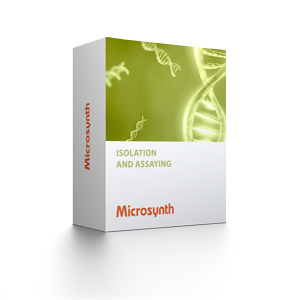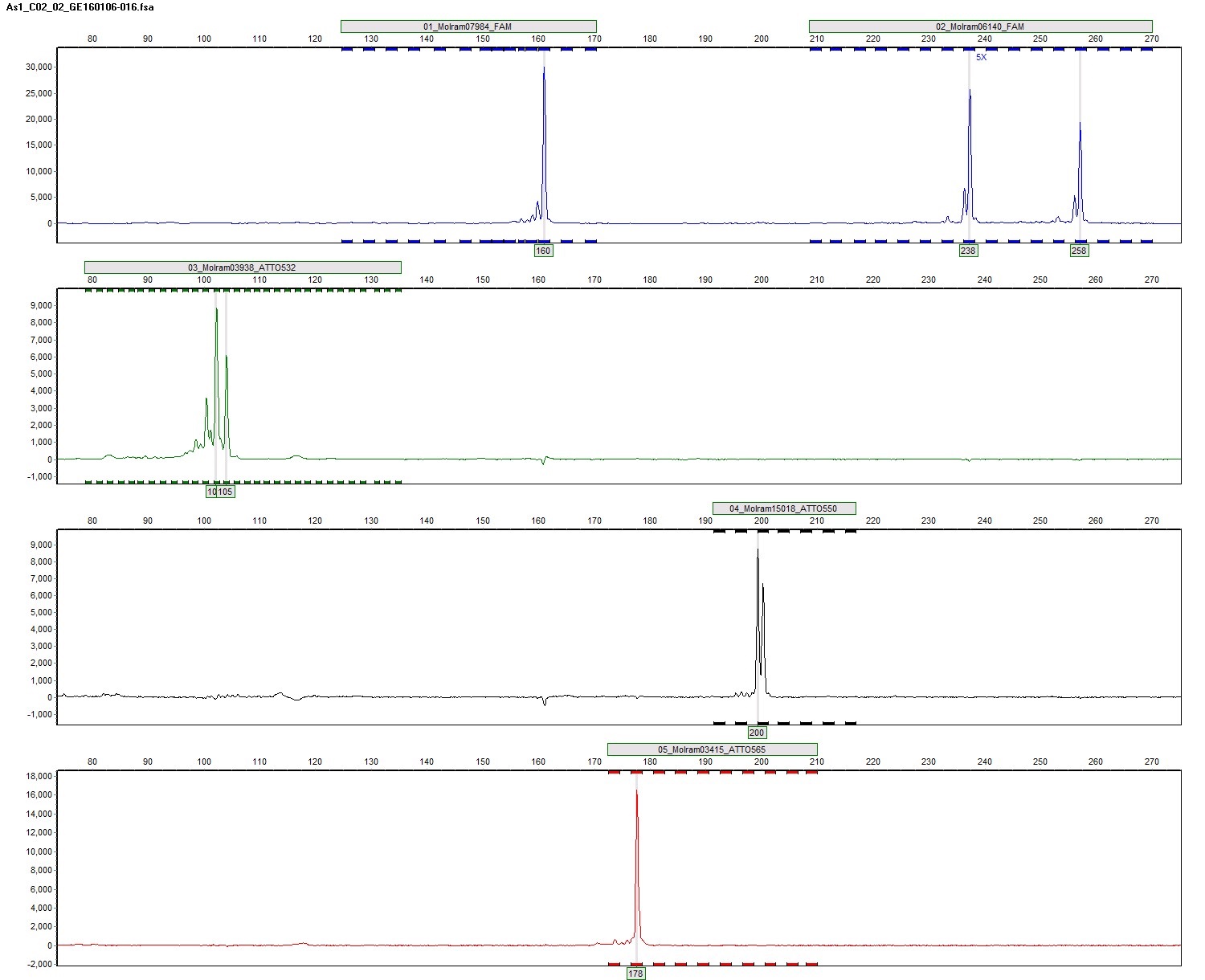
Back to top
Fragment Length Analysis

Comprehensive service packages for fragment length analyses including data analysis. Whether your application is a plain routine service or more complex R&D project, Microsynth can help you.
Features and Benefits
High Quality
- Trusted reliability due to >20 years of experience and the handling of thousands of samples
- State-of-the art equipment (ABI 3730XL) and software (GeneMarker)
- FLA laboratories are ISO/IEC 17025:2017 (STS 0429) accredited
Fast
- Turnaround times down to 2 working days for standard services
Convenient
- Design and synthesis of high-quality fluorescent-labeled PCR primers for individual or multiplex strategies via our in-house oligonucleotide production facility
- Professional data handling and reporting
- Free sample pick-up at places with a Microsynth drop box (ask us if there is a Microsynth drop box close to your lab)
Technical Support
- Dedicated Microsynth application specialists available for project management and troubleshooting
- Experience with difficult-to-assay samples and complete assistance with data interpretation
Services
Microsynth offers the following 3 service types:
Fragment Length Analysis – Labeled PCR Products
This service requires the customer to perform the PCR reaction and submit an aliquot of diluted, labeled PCR products. Microsynth will add the size standard and perform accurate separation of the fragments by capillary electrophoresis on an ABI 3730 XL system. The resulting raw data is provided as FSA files on Microsynth’s webshop.
Data analysis with GeneMarker software is available for a small surcharge. Fragment length reporting includes following information (see also example result further below):
This service requires the customer to perform the PCR reaction and submit an aliquot of diluted, labeled PCR products. Microsynth will add the size standard and perform accurate separation of the fragments by capillary electrophoresis on an ABI 3730 XL system. The resulting raw data is provided as FSA files on Microsynth’s webshop.
Data analysis with GeneMarker software is available for a small surcharge. Fragment length reporting includes following information (see also example result further below):
- Allele calling (determination of allele name and bp size as EXCEL file)
- JPEG exports of allele calling
- Additional information such as height, area, ratio and intensity of signals (customized reporting on request)
Turnaround Time
- 1-2 business days after sample arrival without data analysis (raw data only)
- 2-6 business days after sample arrival with data analysis (FLA report)
Pricing: Flat fee for 1-24 samples, 25-48 samples and for 49-96 samples.
Fragment Length Analysis – Ready-to-load
This service requires the customer to perform the PCR reaction and submit an aliquot of the labeled PCR products in size standard /HiDi formamide. Microsynth will perform accurate separation of the fragments by capillary electrophoresis on an ABI 3730 XL system. The resulting raw data is provided as FSA files on Microsynth’s webshop.
Data analysis with GeneMarker software is available for a small surcharge. Fragment length reporting includes following information (see also example result further below):
- 1-2 business days after sample arrival without data analysis (raw data only)
- 2-6 business days after sample arrival with data analysis (FLA report)
Pricing: Flat fee for 1-24 samples, 25-48 samples and for 49-96 samples.
Fragment Length Analysis – Ready-to-load
This service requires the customer to perform the PCR reaction and submit an aliquot of the labeled PCR products in size standard /HiDi formamide. Microsynth will perform accurate separation of the fragments by capillary electrophoresis on an ABI 3730 XL system. The resulting raw data is provided as FSA files on Microsynth’s webshop.
Data analysis with GeneMarker software is available for a small surcharge. Fragment length reporting includes following information (see also example result further below):
- Allele calling (determination of allele name and bp size as EXCEL file)
- JPEG exports of allele calling
- Additional information such as height, area, ratio and intensity of signals (customized reporting on request)
Turnaround Time
- 1-2 business days after sample arrival without data analysis (raw data only)
- 2-6 business days after sample arrival with data analysis (FLA report)
Pricing: Flat fee for 1-24 samples, 25-48 samples and for 49-96 samples.
Fragment Length Analysis – Customized
Customized service from DNA isolation over PCR optimization to fragment analysis including reporting is available.
Since every project is different, please get in contact with a Microsynth application specialist to discuss your project. Prior to contacting us, please ask yourself following questions:
- DNA/RNA isolation to be outsourced? If yes which kind of organism, tissue or source do you work with?
- Expected number of samples (single analysis, repeated analysis)?
- Delivery of samples (amount, quality and container)?
- Assay established? Single or multiplex assay?
- Number of controls to be included?
- Type of data needed (raw data, analyzed data, report)?
- Test samples available? Especially in case of larger projects, we prefer to perform initial testing in order to make a good bid.
Applications
The type of applications that can be covered with fragment length analysis are following:
Microsatellite (STR) Analysis: Short tandem repeats (STRs), also called microsatellites, are polymorphic DNA loci present throughout the genome, consisting of repeated nucleotide sequences (up to 6 or more bases). In a typical STR analysis, microsatellite loci are amplified by PCR using dye labeled forward and unlabeled reverse primers. Separation occurs via capillary gel electrophoresis. Main applications include:
- Cell line authentication
- Human, animal, and plant genotyping
- Linkage mapping
- Animal/plant breeding
- Pathogen sub‐typing
- Genetic diversity
- Microsatellite instability
- Loss of heterozygosity (LOH)
- Inter‐simple sequence repeat (ISSR)
- Multilocus Variant Analysis (MLVA)
- Paternity Testing
- Population Genetics
DNA Fingerprinting: Amplified fragment-length polymorphism (AFLP) is a DNA fingerprinting method that employs restriction enzyme digestion of DNA followed by selective amplification of a subset of fragments and separation by capillary gel electrophoresis. Main applications include:
- Microbial genome typing
- Animal or plant genome typing
- Creation of genetic maps of new species
- Genetic diversity and molecular phylogeny studies
- Establishment of linkage groups among crosses
SNP Genotyping: SNPs (single nucleotide polymorphisms) or point mutations are the most common types of genetic variation determining to a major part the phenotype diversity between individuals. SNPs occur approximately once every 100 to 300 bases and can be detected by various different techniques such as RFLP, SSCP, sequencing, or in case of fragment length analysis by
- SNaPshot Multiplex analysis
Relative Fluorescence Quantitation: Relative fluorescence applications compare peak height or area between two samples. Common techniques include namely Qualitative Fluorescence (QF) PCR and Multiplex Ligation‐dependent Probe Amplification (MLPA). Main applications include
- LOH in tumor samples,
- Copy Number Variation (CNV)
- Aneuploidy detection
Replacement of manual gel electrophoresis: Gel electrophoresis is still the standard lab procedure for separating DNA by size (e.g., length in base pairs) for visualization and purification. Thus, you can determine the approximate length of a DNA fragment by running it on an agarose gel alongside a DNA ladder. However, there are also limitations. First, there is no method for accurately calculating fragment sizes even with a size ladder. Second, multiplexing is not possible when product sizes from multiple primer pairs (markers) are similar in size. Finally, agarose gels do not have the resolution capabilities that capillary electrophoresis has (resolution capability of capillary fragment analysis is 1 base pair).
Hence an increasing number of scientists shifted to replace the manual approach by automated fragment analysis. Service providers such as Microsynth offer fast and reliable fragment analysis services at affordable costs. Similar as for Sanger sequencing, samples are dropped into a collection box, shipped free of charge to the service provider to be analyzed. 2-3 working days later the processed data (fragment size, intensity of signal) will be sent back to customer in an electronic format (ready for publishing).
Hence an increasing number of scientists shifted to replace the manual approach by automated fragment analysis. Service providers such as Microsynth offer fast and reliable fragment analysis services at affordable costs. Similar as for Sanger sequencing, samples are dropped into a collection box, shipped free of charge to the service provider to be analyzed. 2-3 working days later the processed data (fragment size, intensity of signal) will be sent back to customer in an electronic format (ready for publishing).
Standard Marker Dyes
Microsynth offers the following filter sets:
| Dye Set Name | Matrix Type | Blue | Green | Yellow | Red | Orange |
| Powerplex_4C | 4 dye | FAM | JOE | TAMRA | CXR | |
| Powerplex_4C-RCT | 4 dye | FAM | JOE | TAMRA | CXR | |
| DS-30_D | 4 dye | 6-FAM | HEX | NED | ROX | |
| DS-30_D-RCT | 4 dye | 6-FAM | HEX | NED | ROX | |
| DS-33_G5 | 5 dye | 6-FAM | VIC | NED | PET | LIZ |
| DS-33_G5-RCT | 5 dye | 6-FAM | VIC | NED | PET | LIZ |
| Mic-G5 | 5 dye | FAM | ATTO532 | ATTO550 | ATTO565 | Dyomics630 |
| Mic-G5-RCT | 5 dye | FAM | ATTO532 | ATTO550 | ATTO565 | Dyomics630 |
RCT: This dye set reduces signal intensity and potential crosstalk of capillaries. Higher concentration peaks can be used without going offscale.
If customer chooses ready-to-load service, basically any size standard can be added. Microsynth needs to know which size standard customer is using for sizing DNA fragments in the 20-600 nucleotides range or for larger fragments.
Microsynth can synthesize forward primers with above mentioned fluorescent dyes except the patent protected dyes PET and LIZ. However, cost-effective alternative dyes with equal performance are available.
How to Order
1. How to order labels (non-prepaid):
- Enter our webshop
- Click on "Plates" under Fragment Length Analysis and follow the further instructions
2. How to register your samples:
- Prepare your samples arrayed in a 96-well plate according to our sample requirements.
- Fill the order form on our webshop.
- Print the order form and put it together with the samples in a plastic bag or envelope. Drop the samples in the next Microsynth collection box. To find the closest collection point please login our online shop and click “Options & Preferences” under DNA Sequencing and find details under “Collection Points”. In case there is no collection box in your vicinity, ship your samples to Microsynth in Balgach, Switzerland. See here for your shipment options.
- New customers will get an introductory discount of 50% for the first plate to be analyzed at Microsynth.



